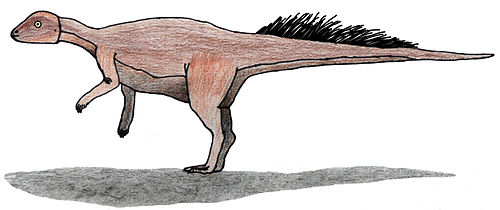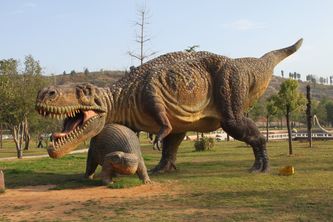Micropachycephalosaurus. This is the longest name any dinosaur has been given to date. With such a formidable name it might seem the creature was an enormous monster. But was it? The clue lies in its name. Let’s break it down.
Origins of the name
Micro in Greek means tiny. For example, microscope refers to an instrument that’s used to view the tiniest of bugs.
Pachy is also a Greek word that means thick. Cephalo is the Greek word for head.
And we are all familiar with the saurus bit. Saura in Greek refers to, you guessed it right, lizards! The word dinosaur literally means terrible lizard.
That’s a lot of Greek for one day, but this is how paleontology works. Paleontologists, people who study fossils, prefer to use Greek names for every new fossil that is discovered.
Coming back to our guy, the name translates to ‘tiny thick-headed lizard’.
Micropachycephalosaurus was a small dino
Not so surprisingly, Micropachycephalosaurus is one of the smaller dinosaurs that we know.
Compared to a regular T. Rex, which was around 40 feet in length, and weighed between 20,000 to 30,000 pounds, Micropachy had a nose to tail length between 2 to 3 feet and weighed between 5 to 10 pounds – the size of a small dog. Tiny indeed, especially in the dino world.
What did Micropachycephalosaurus look like?

What does the rest of the name say about this creature? Thick headed in this case doesn’t mean ‘stupid’.
In dino lingo, thick headed lizards or the Pachycephalosaurs belong to a group of relatively small dinosaurs (between 7 to 10 feet in length) that had thick, domed bony skulls which they used to head butt each other in quite the same way mountain goats do.
The hands (forelimbs) of Pachys were shorter than their legs (hindlimbs). They were bipedal (walked on two), terrestrial (lived on the ground, as opposed to living in water, or on trees) and herbivores (mostly ate plants). These creatures thrived in parts of Asia and North America in the Late Cretaceous period, roughly between 70 to 80 million years ago.
Discovery of Micropachycephalosaurus
When the Chinese paleontologist Dong Zhiming discovered a rather small Late Cretaceous dinosaur fossil on a cliff in Shandong Province in Eastern China in 1972, he decided to name it Micropachycephalosaurus hongtuyanensis. Yeah, that’s the complete scientific name for this tiny creature.
According to Zhiming’s original analysis the creature was a Pachycephalosaur, but tinier, and hence the micro at the beginning of the name.
But being the only specimen of its kind and that too an incomplete and fragmented one, has led to some serious trouble for this small fossil lizard.
Problems with the Micropachycephalosaurus name
When scientists decided to reexamine its position on the tree of life in 2006, they found no evidence in support of its Pachy status. The fact that the Micropachy skull could not be located in the museum collection in China didn’t help either.
Imagine coming up with a fancy record-setting 23-letter name for a dinosaur, based on the thickness of its head, only to realize that the head is untraceable.
With no other Micropachy specimen available, scientists are no longer keen to accommodate this longest named dinosaur within the Pachycephalosaurus club.
The name Micropachycephalosaurus, it turns out, is somewhat misleading. Recent research on the incomplete fossil suggests that Micropachy would be a better fit in the Ceratopsia club, a category that includes beaked dinosaurs with horned faces (Greek keras = horn, ops = face).
The most famous Ceratopsian is the terrific Triceratops, not bad company for a tiny dinosaur of uncertain pedigree whose head has gone missing.
What we know for certain about our dino?
Given all the confusion about the category that Micropachy belongs to, what do we know for certain about this creature?
No matter where Micropachy is eventually placed in case more fossil specimens of its kind are unearthed in future, scientists are sure that it was indeed a small dinosaur, not longer than 3 feet in length.
It definitely walked on its two longer and stronger hind legs, lived on the ground and survived primarily on a vegetarian diet in the woodlands of China in the Late Cretaceous, 70 million years ago.
Some scientists suggest that it had quills along the length of its tail.
Micropachy probably lived in a flock with many members of its family, and was a fast runner, since that was the easiest way to escape potential predators – bigger meat eating dinosaurs.
Life was tough in the Late Cretaceous, especially for the poor dinosaurs, most of whom would be wiped out at the end of Cretaceous due to a terrible asteroid collision with earth.


